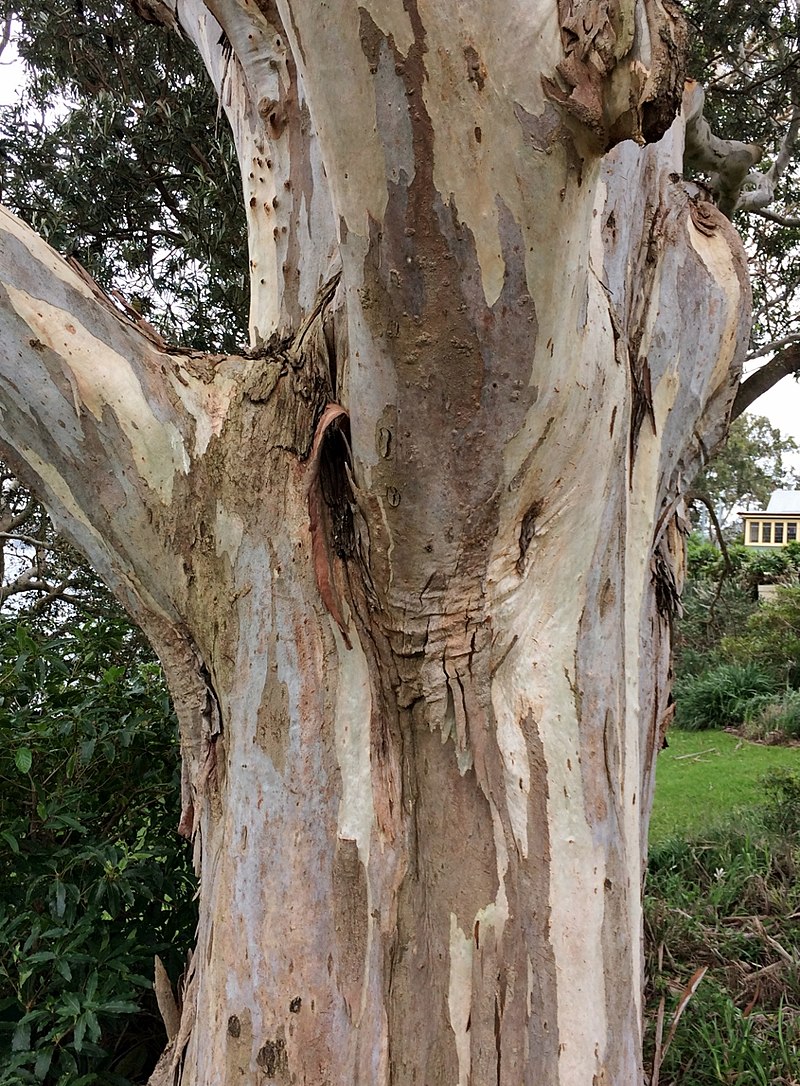Eucalyptus tereticornis

|
|
Eucalyptus tereticornis Common Names: Forest red gum, Blue gum, Red irongum,
Red gum, Bastard box Scientific
Classification Kingdom: Plantae Clade: Tracheophytes Clade: Angiosperms Clade: Eudicots Clade: Rosids Order: Myrtales Family: Myrtaceae Genus: Eucalyptus Species: E. tereticornis Synonyms: Eucalyptus coronata Tausch ex Maiden, Eucalyptus insignis Naudin, Eucalyptus populifolia Desf., Eucalyptus subulata A.Cunn. ex Schauer, Eucalyptus umbellata (Gaertn.) Domin, Leptospermum umbellatum Gaertn. Morphological Description Eucalyptus tereticornis is a tall, evergreen tree, typically 20–50 meters tall,
occasionally reaching 60 meters, with a straight trunk and open crown. Its key
characteristics include: · Bark: Smooth, shedding in irregular patches to reveal white, grey,
or bluish underbark; rough at the base in older trees (Fern, 2024). · Leaves: Juvenile leaves ovate, adult leaves lanceolate to falcate
(10–20 cm × 1–2.5 cm), glossy green, alternate, with a prominent midrib (Prance
& Jongkind, 2015). · Flowers: White, in clusters of 7–11, axillary or terminal umbels, 1–2
cm diameter; bloom seasonally, attracting pollinators like bees (Kew Science,
n.d.). · Fruit: Woody, hemispherical capsules (0.5–0.8 cm), with 3–4 valves,
containing small, dark seeds; dispersed by gravity (Fern, 2024). Distribution and Habitat Eucalyptus tereticornis is native to eastern Australia and southern New Guinea, widely
introduced globally: · Geographic Range: Native to Queensland, New South Wales,
Victoria, and Papua New Guinea; introduced to Nigeria, India, Brazil, South
Africa, China, and Southeast Asia; common in Nigeria’s northern and southern
regions for plantations (Kew Science, n.d.). · Habitat: Thrives in seasonally dry tropical and subtropical biomes,
including open forests, woodlands, and savannas; adapts to a range of soils
(sandy, loamy, clay; pH 4.5–7.5); prefers 800–2,000 mm annual rainfall and
elevations up to 1,800 m (Fern, 2024). · Ecological Role: Provides nectar and pollen for bees;
stabilizes soils in degraded areas; can be invasive, outcompeting native
species in introduced regions (Burkill, 1985). Ethnopharmacology Eucalyptus tereticornis is valued in Nigerian and global traditional medicine,
particularly for its essential oil, with robust ethnopharmacological validation · Antimicrobial: In Nigeria, leaf decoctions treat respiratory infections. · Anti-inflammatory: Leaf infusions are used for arthritis in
Nigeria. Methanolic leaf extract (100 mg/kg) reduced carrageenan-induced paw
edema in rats by 50%, attributed to flavonoids and 1,8-cineole (Silva et al.,
2003). · Analgesic: Leaf extracts relieve pain. Essential oil (100 mg/kg)
reduced formalin-induced pain in mice by 60%, with dose-dependent effects via
opioid and non-opioid pathways (Chandorkar et al., 2021). · Antioxidant: Leaves combat oxidative stress. Methanolic leaf extract
showed DPPH scavenging (IC50: 4.5 µg/mL), linked to phenolic acids (gallic,
caffeic) and flavonoids (quercetin) (Chan et al., 2014). · Respiratory Relief: In Nigeria, leaf steam inhalation treats
colds and bronchitis. Essential oil (1,8-cineole-rich) reduced airway
inflammation in guinea pigs, supporting use for asthma and sinusitis (Bastos et
al., 2009). · Antifungal: Leaf extracts treat skin infections. Essential oil
inhibited Candida albicans and Trichophyton mentagrophytes (MIC: 1–2 mg/mL), validating use for dermatophytosis
(Cimanga et al., 2002). · Antidiabetic Potential: In Nigeria, leaf decoctions are used for
diabetes. While specific studies on E. tereticornis are limited, related species like E. globulus reduce blood glucose in diabetic rats,
suggesting potential due to shared flavonoids (Feng et al., 2019). ⚠ Toxicity Profile: Eucalyptus tereticornis essential oil is safe at low, therapeutic
doses but toxic in high amounts. Ingestion of undiluted oil (>5 mL) may
cause nausea, vomiting, diarrhea, or neurological symptoms (seizures, coma).
Acute toxicity studies showed no mortality in rats at doses up to 2,000 mg/kg,
but high doses caused mild liver enzyme elevation (ALT increased by 10%). Skin
contact with concentrated oil may cause dermatitis. Use is contraindicated in
pregnancy, for children under 6, and without dilution or medical supervision.
Avoid inhalation in high concentrations to prevent respiratory irritation
(Chandorkar et al., 2021). Additional Uses · Timber: Hard, durable wood (density 900–1,100 kg/m³) used in Nigeria
for construction, railway sleepers, and furniture; resistant to termites but
prone to splitting if not dried properly (Fern, 2024). · Apiculture: Major nectar source in Nigeria, supporting honey production
due to abundant flowers (Burkill, 1985). · Reforestation: Planted in Nigeria for erosion control and carbon
sequestration; fast-growing, suitable for degraded lands (Fern, 2024). · Industrial: Essential oil used in Nigeria for soaps, disinfectants, and
insect repellents; pulp used for paper production (de Castro et al., 2019). References
External Links More Pictures |
|
| Compounds of Eucalyptus tereticornis |
|
| References |